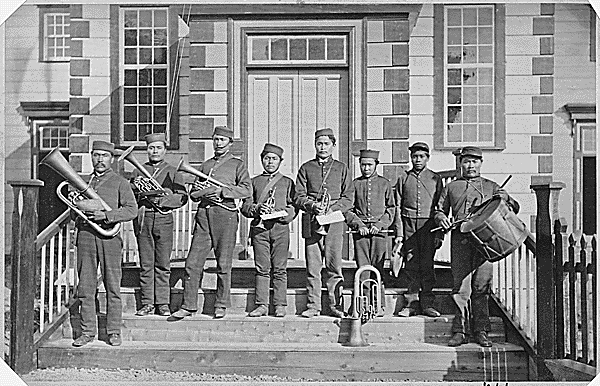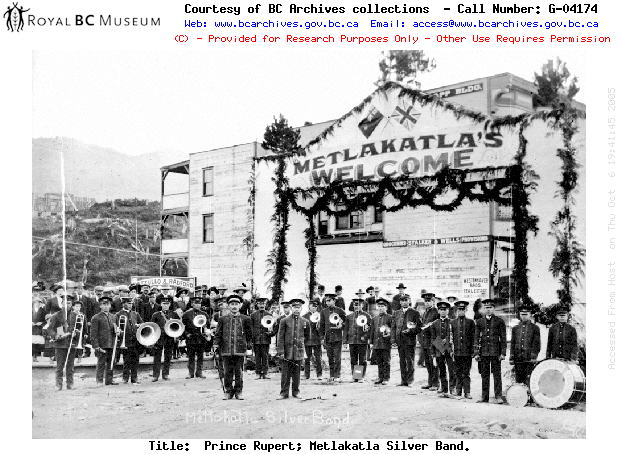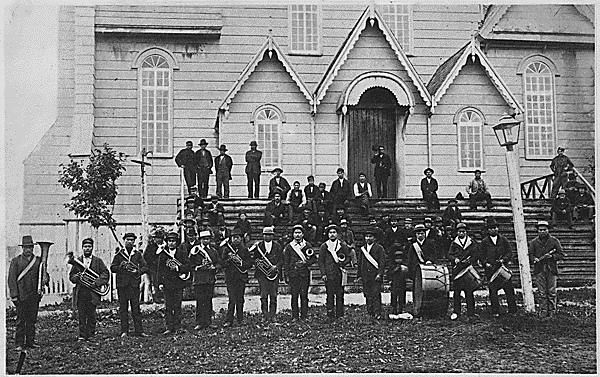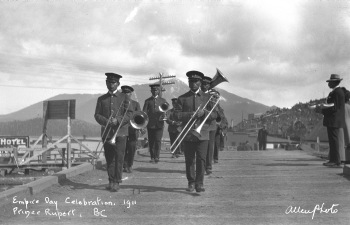VABBS
HomeAbout VABBS
Members
Events
News Archive
What is a Brass Band?
Research Project: History of Brass Bands in BC
Links
Little Mountain Brass BandBrass Belles
Other Links
Contacts
Brian StrideJim Littleford
Web Administrator
Research Project: History of Brass Bands in British Columbia
Metlakatla
Credits
Much of the information in this article is summarized from the following publications:

Gallery of the Open Frontier, WELLC-PHOTOS-P666.
Metlakatla Band, 1881
The Metlakatla Brass Band was the first adult First Nations brass band in British Columbia. The Band was so popular and successful that it became the model for many other First Nations communities, who aspired to have their own band.
The Bandís history is inextricably linked with that of the Church of England lay missionary, William Duncan. A brief historical outline would include:
- In May, 1862, William Duncan, along with about 50 First Nations converts, moved to the small Tsimshian village of Metlakatla.
- While dates vary, it appears that around 1871 Duncan established a brass band.
- In 1887 Duncan seceded from the Church of England. Shortly thereafter he and about 800 followers moved to Annette Island in Alaska. There they formed the community of New Metlakatla.
- The Metlakatla Brass Band continued to operate, despite the loss of many bandsmen to New Metlakatla.
- Shortly after founding the community of New Metlakatla a brass band was formed in that community.
The original brass band established by Duncan ultimately numbered twenty-one players. The instruments were a gift from a London silk manufacturer. The acquisition of instruments is related by Archdeacon William Collison:
"In 1870, on the return of Mr. William Duncan from his first furlough to England, he was delayed in San Francisco, awaiting the departure of the steamer for Victoria. During this delay he met a friend who was much interested in his mission. This gentleman had a complete set of band instruments at his disposal, which he offered as a gift to Mr. Duncan for Metlakatla. These were gladly accepted, and conveyed up the coast by Mr. Duncan. He had them hung up around the room which he used as office and study. Here they remained unused for several years."1
Leaving the instruments hanging around his office seems to be contradictory to the original intent of the gift. However, Archdeacon Collison continues:
"In 1879, I was one day consulting with Mr. Duncan, when it occurred to me to make a suggestion regarding the instruments. "You are about shortly to visit Victoria," I said; "why not endeavour to find a musician who will come up here for the winter and instruct some of the young men in the use of these instruments? And," I added, "I am prepared to board and lodge him, and otherwise assist." Mr. Duncan readily agreed to my proposal, and on his visiting Victoria shortly afterwards, he succeeded in finding a very capable musician, a German, who had formerly been bandmaster in a Prussian cavalry regiment. As he had the winter months at his disposal, he accepted the offer and came up the coast. We selected a sufficient number of young men, all of whom were most eager to learn, and under such an ardent and proficient instructor they made rapid progress in both theory and practice. Before the winter was over their confused medley of sounds gradually became blended and harmonious. It was a proud moment for both the master and his pupils when they came forth and rendered several airs with proficiency."
Archdeacon Collisonís date of 1879 contradicts other dates given for the start of the band. In fact, records show the band performing in public as early as 1876. Whatever the date the band was now under way.

Metlakatla Silver Band, ca. 1910. This ensemble has a few clarinets.
In the story of William Duncan the following account is rendered:
"In Ireland Duncan bought a weaving machine which he learned to take apart and reassemble. Then he boarded a steamer for New York. He had to wait almost a week in San Francisco for a ship to Victoria, but made good use of his time by learning a new technique for dressing deer-skins, and visiting another spinning mill. He also took music lessons on a brass band set donated in England for the mission. A quick learner in both mechanics and music, he grasped enough about each instrument to teach the natives the basics.""When they first saw the instruments the Indians thought they were magic. Their only music apart from drumming consisted of a "croaking noise," as Duncan described it, made by blowing into an animal bladder, as well as the sound made by blowing on blades of grass. Otherwise, the men chanted and the women clapped hands. "I took a cornet and played a tune they knew, God Save the Queen," Duncan recalled. "They were all amazed and looked at one another in surprise. I took the instruments down off the wall and gave one to each and told them to go out in the bushes and blow. It was bedlam." But the Indians had a flair for music and it was not long before they were playing enthusiastically and well. A music teacher was imported from Victoria for two months to give advanced training. A brass band was formed, the first on the coast. It became a trademark of Metlakatla. Duncan later acquired some old U.S. army uniforms from Alaska for the bandsmen to wear. They polished the brass buttons as brightly as their instruments."2
The ex-Prussian bandmasterís name is referred to as Ephor, but was probably Gustavus Epner, who had arrived in Victoria from Germany in 1862. Ephor (or Epner) stayed the winter and completed his contract. When he left the band was assigned to one of his students, Roderick Vokel, who carried on the work which Ephor had begun. Vokel was later hired by the villagers of Kincolith to teach their members to play. A final word from Archdeacon Collison:
"Little wonder that they had succeeded so well. Both the instructor and his pupils were almost music mad. Often in the midnight hours, when all were asleep, this disciple of Orpheus would rouse the household by springing from his bed to the floor with a bound, as though just released from some dread spell, and seizing his violin, would discourse some sweet strain on it for a short time, and then betaking himself to his bed again, would sleep peacefully till the morning."
One of the first appearances of the Metlakatla band came with the 1876 visit of Governor-General and Lady Dufferin. A Toronto newspaper writer described the group of bandsmen as "gorgeous in cast-off uniforms of United States soldiers, purchased at a sale of condemned military clothing recently held in Alaska." 3 Lady Dufferin, whose impressions of vice-regal life in Canada were later published, was not sufficiently moved by the novelty of an Indian brass band. What she found odd was that the band should play atop the prison.4

Gallery of the Open Frontier, WELLC-PHOTOS-P70.
Metlakatla Brass Band in front of the church at Metlakatla, ca. 188-.
The Metlakatla band performed at most special events and all important visitors. These included:
- Bishop Bompas (1877)
- Admiral James C. Prevost (1878)
- Superintendent of Indian Affairs I. W. Powell (1879 and 1881)
After the secession of Duncan and 800 followers in 1887, Bishop William Ridley somehow managed to keep the Metlakatla band functioning.
At New Metlakatla a new brass band was formed. By the early 1900s other musical ensembles were formed including "a reed band, a string band, an orchestra, a ladies' orchestra, and a girls' zobo band."5
The old Metlakatla brass bands performed into the 1910s, while the New Metlakatla band carried on until at least 1924 at which time it was under the direction of Job Nelson.
- William Henry Collison, W.H. (1981) In the Wake of the War Canoe. Sono Nis Press, Victoria, British Columbia.
- Peter Murray (1985) The Devil and Mr. Duncan, A History of the Two Metlakatlas. Sono Nis Press, Victoria, British Columbia.
- Toronto Mail, September 19, 1876, quoted in Stock (1881), p. 105.
- Marchioness of Dufferin and Ava, My Canadian Journal 1872-8 (1891), p. 263.
- Arctander, J.W. The Apostle of Alaska. New York: Fleming H. Revell, 1909, p. 337.

J.D. Allen Photographic Company, Prince Rupert City and Regional Archives, 435.
Metlakatla Brass Band marching during the Empire Day Celebrations, May 24, 1911.
1911.jpg)
J.D. Allen Photographic Company, Prince Rupert City and Regional Archives, 440.
Metlakatla Brass Band marching during the Empire Day Celebrations, May 24, 1911.
Author: Brian Stride (2006)
Return to First Nations Brass BandsUpdated 2007 Jan 06, 18:23 EST/EDT


